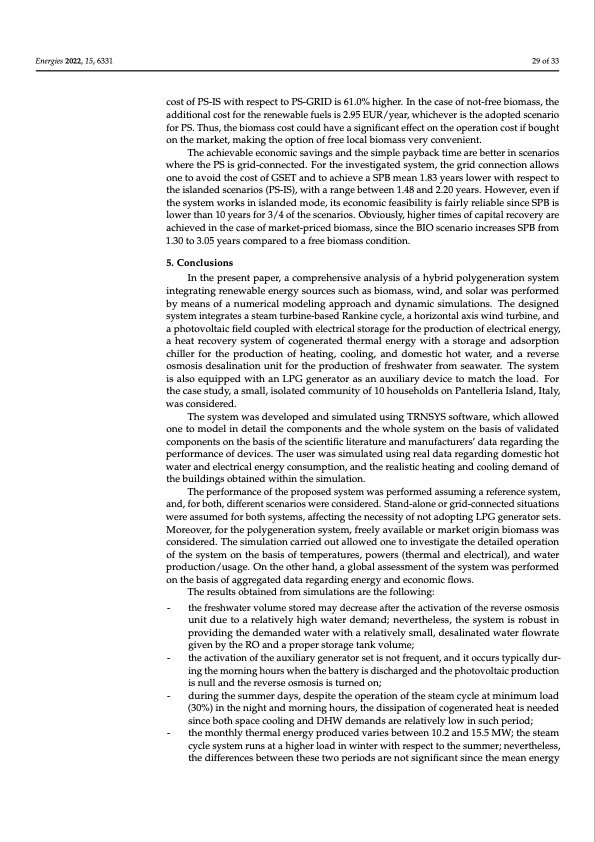
PDF Publication Title:
Text from PDF Page: 029
Energies 2022, 15, 6331 29 of 33 cost of PS-IS with respect to PS-GRID is 61.0% higher. In the case of not-free biomass, the additional cost for the renewable fuels is 2.95 EUR/year, whichever is the adopted scenario for PS. Thus, the biomass cost could have a significant effect on the operation cost if bought on the market, making the option of free local biomass very convenient. The achievable economic savings and the simple payback time are better in scenarios where the PS is grid-connected. For the investigated system, the grid connection allows one to avoid the cost of GSET and to achieve a SPB mean 1.83 years lower with respect to the islanded scenarios (PS-IS), with a range between 1.48 and 2.20 years. However, even if the system works in islanded mode, its economic feasibility is fairly reliable since SPB is lower than 10 years for 3/4 of the scenarios. Obviously, higher times of capital recovery are achieved in the case of market-priced biomass, since the BIO scenario increases SPB from 1.30 to 3.05 years compared to a free biomass condition. 5. Conclusions In the present paper, a comprehensive analysis of a hybrid polygeneration system integrating renewable energy sources such as biomass, wind, and solar was performed by means of a numerical modeling approach and dynamic simulations. The designed system integrates a steam turbine-based Rankine cycle, a horizontal axis wind turbine, and a photovoltaic field coupled with electrical storage for the production of electrical energy, a heat recovery system of cogenerated thermal energy with a storage and adsorption chiller for the production of heating, cooling, and domestic hot water, and a reverse osmosis desalination unit for the production of freshwater from seawater. The system is also equipped with an LPG generator as an auxiliary device to match the load. For the case study, a small, isolated community of 10 households on Pantelleria Island, Italy, was considered. The system was developed and simulated using TRNSYS software, which allowed one to model in detail the components and the whole system on the basis of validated components on the basis of the scientific literature and manufacturers’ data regarding the performance of devices. The user was simulated using real data regarding domestic hot water and electrical energy consumption, and the realistic heating and cooling demand of the buildings obtained within the simulation. The performance of the proposed system was performed assuming a reference system, and, for both, different scenarios were considered. Stand-alone or grid-connected situations were assumed for both systems, affecting the necessity of not adopting LPG generator sets. Moreover, for the polygeneration system, freely available or market origin biomass was considered. The simulation carried out allowed one to investigate the detailed operation of the system on the basis of temperatures, powers (thermal and electrical), and water production/usage. On the other hand, a global assessment of the system was performed on the basis of aggregated data regarding energy and economic flows. The results obtained from simulations are the following: - the freshwater volume stored may decrease after the activation of the reverse osmosis unit due to a relatively high water demand; nevertheless, the system is robust in providing the demanded water with a relatively small, desalinated water flowrate given by the RO and a proper storage tank volume; - the activation of the auxiliary generator set is not frequent, and it occurs typically dur- ing the morning hours when the battery is discharged and the photovoltaic production is null and the reverse osmosis is turned on; - during the summer days, despite the operation of the steam cycle at minimum load (30%) in the night and morning hours, the dissipation of cogenerated heat is needed since both space cooling and DHW demands are relatively low in such period; - the monthly thermal energy produced varies between 10.2 and 15.5 MW; the steam cycle system runs at a higher load in winter with respect to the summer; nevertheless, the differences between these two periods are not significant since the mean energyPDF Image | Hybrid Polygeneration System Based on Biomass Wind and Solar Energy

PDF Search Title:
Hybrid Polygeneration System Based on Biomass Wind and Solar EnergyOriginal File Name Searched:
energies-15-06331-v2.pdfDIY PDF Search: Google It | Yahoo | Bing
Turbine and System Plans CAD CAM: Special for this month, any plans are $10,000 for complete Cad/Cam blueprints. License is for one build. Try before you buy a production license. More Info
Waste Heat Power Technology: Organic Rankine Cycle uses waste heat to make electricity, shaft horsepower and cooling. More Info
All Turbine and System Products: Infinity Turbine ORD systems, turbine generator sets, build plans and more to use your waste heat from 30C to 100C. More Info
CO2 Phase Change Demonstrator: CO2 goes supercritical at 30 C. This is a experimental platform which you can use to demonstrate phase change with low heat. Includes integration area for small CO2 turbine, static generator, and more. This can also be used for a GTL Gas to Liquids experimental platform. More Info
Introducing the Infinity Turbine Products Infinity Turbine develops and builds systems for making power from waste heat. It also is working on innovative strategies for storing, making, and deploying energy. More Info
Need Strategy? Use our Consulting and analyst services Infinity Turbine LLC is pleased to announce its consulting and analyst services. We have worked in the renewable energy industry as a researcher, developing sales and markets, along with may inventions and innovations. More Info
Made in USA with Global Energy Millennial Web Engine These pages were made with the Global Energy Web PDF Engine using Filemaker (Claris) software.
Sand Battery Sand and Paraffin for TES Thermo Energy Storage More Info
| CONTACT TEL: 608-238-6001 Email: greg@infinityturbine.com | RSS | AMP |